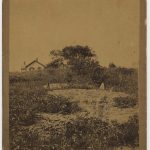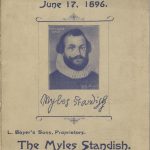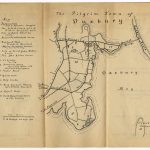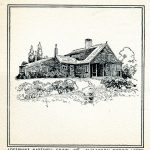Coming to a Pilgrim Town
Coming to a Pilgrim Town: By the mid-19th century, memory had faded about the physical sites of the earliest town residents. When Justin Winsor penned his History of the Town of Duxbury in 1849, there was already debate over where the first meeting house was erected. No one knew where the earliest burials, including that of Myles Standish, were located. When the bottom fell out of the local shipbuilding industry in the 1850s, taking Duxbury’s wider economy with it, there was little to sustain the town other than farming and shoemaking. A boon came from an unexpected quarter with the publication of Henry Wadsworth Longfellow’s fictionalized poem, The Courtship of Miles Standish, in 1858. It created an interest in Standish along with John and Priscilla Alden. In the post-Civil War years, Duxbury’s now popularized Pilgrim history, combined with the beauty of its Bay and beaches, initiated a tourist boom.
Explore an original brochure from the Myles Standish Hotel in Duxbury, Massachusetts, ca. 1893. (Hint: Click the “Fullscreen” button in the toolbar below to see a larger size version)
By 1872, the Myles Standish Hotel, the centerpiece of the “Standish Shore” development, stood waiting to accept patrons disembarking from the newly constructed railroad. In the same year, a grand monument began construction, dedicated to Myles Standish and staking a claim on national mythology. The growing concern for collective memory soon resulted in the Duxbury Rural Society’s reclamation of the overgrown and forgotten Old Burying Ground on Chestnut Street, which led to the efforts to discover the remains of Standish in 1889 and 1891.
Entrepreneurs from Boston as well as intrepid Duxburyites began buying up large swaths of waterfront land to be sold as summer homes. These developments included numerous street names that harkened back to the early colonial days, such as Soule Ave, Mullins Ave., Pilgrim Rd., and Elder Brewster Rd. Native names were also used, e.g. Sagamore and Massasoit. By the end of the century and into the next, Duxbury was known as a bucolic retreat steeped in Pilgrim lore, and the growing tourism industry created a demand for services, such as inns, tea-rooms, restaurants and camps. An influx of people moved to Duxbury, building businesses catering to the summer crowds. These newcomers included women, immigrants and people of color.
Click on an object to learn more:
This exhibition is divided into four themes: Digging Duxbury, Massachusetts; Coming to a Pilgrim Town; Collecting in a Pilgrim Town; and, Lasting Legacy.
Click the buttons to explore different parts of the town’s Pilgrim past and to view objects from the collections of the Duxbury Rural & Historical Society.
Please consider making a donation to support the Duxbury Rural & Historical Society & community projects like this exhibition. We depend on your support, now more than ever. Thank you.
All objects, text and materials in this digital exhibition are owned or copyrighted by the Duxbury Rural & Historical Society and may not be reproduced, copied or distributed without permission. © 2020, Duxbury Rural & Historical Society. All Rights Reserved. Please contact 781-934-6106 for more information.
Digging Duxbury
The quest for archaeological evidence of Duxbury’s Pilgrim past began with an 1833 dig, one of the earliest in U.S. history.
Coming to a Pilgrim Town
Coming to a Pilgrim Town
Duxbury’s Pilgrim history, combined with the town’s natural beauty, initiated a tourist boom.
Collecting in a Pilgrim Town
Collecting in a Pilgrim Town
The tourism boom brought another enterprise, the creation and sale of Pilgrim-themed souvenirs.
Lasting Legacy
Duxbury's Lasting Legacy
Duxbury never forgot its Pilgrim origins. How could it? The names continue to generate interest today.
Return to Exhibition Main Page.













